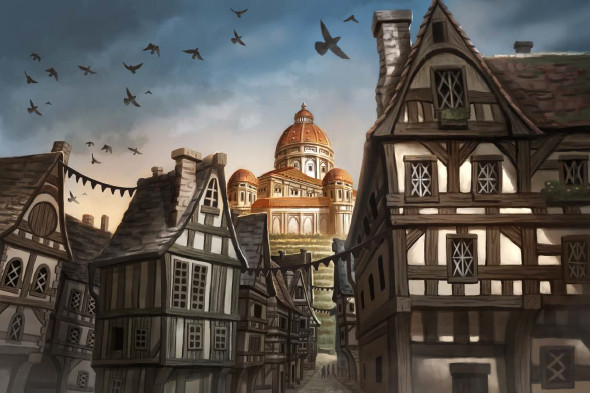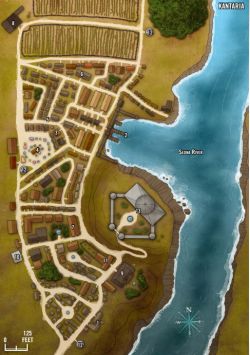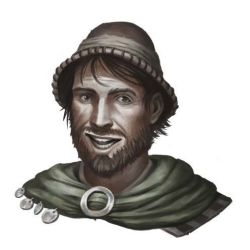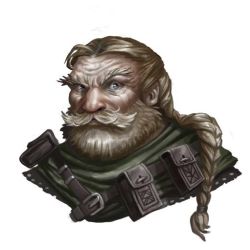Kantaria

Introduction
| Kantaria | |
|---|---|
| Cité | |
| Nation | Cheliax |
| Region | Archduchy of Menador |
| Taille | Small town |
| Population | 1,200 |
| Demographies | 1,004 humans, 97 halflings, 73 dwarves, 18 tieflings, 8 other |
| Gouvernement | Overlord |
| Alignement | Lawful neutral |
| Dirigeant | House Narikopolus / Governor Oppian Nevilindor |
| Carac. | LN small town, Corruption +0; Crime –2; Economy +2; Law +3; Lore +2; Society –2, Qualities sacred site, strategic location
Danger +0 |
| PNJs Notables | |
| Councilor Faydreth Zaine (LG male half-elf wizard 7), Councilor Jalila Hadjara (LG female human monk 6), Councilor Jana Holdus (CG female human bard 5), Councilor Linton Demeer (NE male faceless stalker, alchemist APG 5), Governor Oppian Nevilindor (LG male human cleric of Iomedae 8), Harbormaster Jonas Reikman (N male human fighter 2/rogue 3), Innkeeper Loredana Viorica (NE female human rogue 2), Inquisitor Kalcyra the Just (LN female dwarf inquisitorAPG of Torag 7), | |
| Market Place | |
| Base Value 1,100 gp; Purchase Limit 5,000 gp; Spellcasting 4th; Minor Items 3d4; Medium Items 1d6; Major Items — | |
| Qualité Spéciale | |
Source: Wrath of Thrune, pg(s). 65 | |
- Ah, first time in town, eh? Well, I can tell you all about Kantaria and her great history. We started out as a camp for the armies of Old Taldor. General Kantarikos fought the orcs of the Menador Mountains, those peaks you can see over yonder, and Taldor thanked him with this land. Before long, we had a proper town, and named it Kantaria after the general himself.
- “But that’s not why you’re here, now is it? No, you’re wanting to know about the goddess that walked these same streets. That’s right—while she was still as mortal as you or I, the Inheritor lived in Kantaria, and saved the town from faceless horrors and shapeshifting monstrosities. It was a miracle, I tell you, her Tenth Act. Aye, that’s the house she called home, right up the street, and for just a single silver, I’ll give you a tour and the whole story, including things you won’t hear about in church, if you know what I mean!”
- —Pious Pete, Kantarian local and amateur historian
The town of Kantaria rests atop a hill overlooking the Sedna River in the Archduchy of Menador. Surrounded by fertile farmland and the rich lumber of the nearby Barrowood, Kantaria provides a waypoint for travelers between Nidal and the Chelish heartlands, and for miners and slave trains heading to and from the excavations in the Menador Mountains. The only settlement of note for miles, Kantaria serves as the ducal seat of House Narikopolus, which has ruled Kantaria and the Archduchy of Menador for centuries. However, the town is now most famous as the site of the goddess Iomedae’s Tenth Act.
Sheltered between the northern mountains and the southern forest, Kantaria is protected from the worst effects of the area’s seasonal weather, which fluctuates between striking sunny days and dismal periods of rain. Although recurrent flooding threatens the farms in the nearby hinterlands, Kantaria itself is spared such a calamity thanks to its location on the hillside above the river.[1]
EARLY HISTORY
Soon afer Cheliax was ofcially founded as a province of Taldor in 3007 ar, a Taldan army led by General Kantarikos came to the region to address a growing orc threat in the nearby Menador Mountains. Kantarikos established a command post above the Sedna River, where he could clearly view much of the surrounding region. When Kantarikos retired in the afermath of the long campaign against the orcs, Taldor rewarded the general and several of his ofcers with honorable discharges and land in Cheliax. Most of these retired soldiers settled near the command post that had been their home, and dozens of residences and businesses soon sprang up around the former military fortress. This settlement formed the foundation of the modern town of Kantaria, named in honor of General Kantarikos.
Kantarikos led the town until his death, but lef no descendants, so a governing council took over Kantaria for the next few centuries. The town saw a drastic change in leadership afer the Shining Crusade ended in 3828 ar. An aged Taldan knight named Fiona Narikopolus gained the attention of the empire when she personally battled one of the Whispering Tyrant’s generals on the shores of distant Lake Encarthan, defeating the unholy abomination and scattering an army of undead before her. For her valor in the face of such horrors, Fiona was granted a noble title and the town of Kantaria and its hinterlands as her family estate.
Fiona Narikopolus ruled Kantaria for only a single year before she died of natural causes, passing her title and leadership of the region to her only son, Arakhan, the result of a brief tryst with a fellow soldier during the Shining Crusade. Arakhan had only visited Kantaria a handful of times before Fiona’s death and, following that tragic event, the Narikopolus heir vanished, not even deigning to attend his mother’s funeral. Lacking any true leader, Kantaria entered a short period of chaos and confusion as its citizens attempted to reinstate the town’s former governing council with varying levels of failure.[1]
IOMEDAE’S RULE
Fortune smiled on Kantaria in 3831 ar, when the thenmortal Iomedae visited the town following her recent defeat of the vampire-mage Basilov. While resting on her way to Absalom, Iomedae perceived a strong emanation of evil from several of Kantaria’s governing council members. Iomedae and her entourage confronted them, only to be taken aback when several of the accused revealed themselves as shapechanging faceless stalkers. Battling the horrifc aberrations throughout town, Iomedae and her retinue eventually defeated them, only to leave Kantaria leaderless. Believing that whatever was behind the infestation might soon return, Iomedae offered to defend the town and assist in creating a stable government. Her suspicions were confrmed when an army of faceless stalkers almost immediately attempted to invade the town.
For months, Iomedae repelled constant incursions, eventually facing the true leaders behind the assault—a cabal of veiled masters. The siege culminated in a great battle on the day following the one-year anniversary of Iomedae’s arrival in Kantaria. Pressed on all sides, Iomedae and the town’s surviving defenders retreated into the old command post built by General Kantarikos. The veiled masters discarded any attempt at subtlety and assaulted the fortress directly. Only the timely arrival of Arakhan Narikopolus, the long-missing rightful lord of Kantaria, at the head of a host of adventurers, mercenaries, and soldiers saved the people of Kantaria and restored peace.
In recognition of his valor, Iomedae gifed her sword, Heart’s Edge, to Arakhan to help defend the town should the veiled masters return. She also handed over leadership to him, restoring House Narikopolus’s rule of Kantaria. Iomedae then departed and resumed her journey to Absalom. Soon afer, she ascended into the ranks of divinity, and Kantaria became a sacred site for the goddess’ nascent church.[1]
HOUSE THRUNE
Kantaria changed little over the intervening centuries, though it slowly grew in afuence due to the fame from its direct association with the goddess Iomedae. Even Cheliax’s declaration of independence from Taldor in 4081 ar had little impact on the town. The leaders of House Narikopolus became archdukes of Menador during this time, but Kantaria otherwise remained distant from the politics of greater Cheliax. During the Everwar, Kantaria saw an influx of soldiers passing through on their way to subjugate Nidal, and the town remains a stopping point for those traveling between the two nations to this day.
The outbreak of civil war following Aroden’s death in 4606 ar dramatically impacted Kantaria. While the town remained untouched by the war itself, when House Thrune seized power and took control of Cheliax in 4640 ar, Kantaria contended with the rise of diabolism and the state worship of Asmodeus. Being distant from the new capital of Egorian allowed Kantaria to maintain some independence from Thrune’s various edicts, but Kantaria’s holy signifcance to the church of Iomedae drew unwelcome attention. House Narikopolus became a loyal supporter of Thrune, and to appease the throne, ordered that Kantaria’s former chapel of Aroden be converted into a temple of Asmodeus.
Nevertheless, Kantaria retained its status as a sacred site of Iomedae in the afermath of House Thrune’s ascension, and even enjoyed a modicum of prosperity as the growing slave economy resulted in regular caravans passing through the town as they moved between the cosmopolitan cities of the south and the Menador Mountains, Nidal, and points farther north.[1]
THE GLORIOUS RECLAMATION
When the Glorious Reclamation launched its crusade against House Thrune to restore the faith of Iomedae in Cheliax, the dormant tensions between Kantaria’s Asmodeans and Iomedaeans flared into life. Fourth Sword Knight Oppian Nevilindor, the local leader of the town’s church of Iomedae, worked to avoid any potential crackdown on those disloyal to House Thrune by mediating these conflicts. Due to its status as a sacred site, Kantaria presented an important military and religious objective for the Glorious Reclamation, which had secretly contacted Nevilindor weeks before to prepare for the town’s conquest.
Once House Thrune declared martial law in Cheliax’s major cities, the members of House Narikopolus lef Kantaria for Egorian to present themselves to the imperial court. Seeing the family’s departure as an opportunity, the Glorious Reclamation launched a precision strike on Kantaria, seizing the town in a single day with minimal bloodshed. To maintain order, the Glorious Reclamation appointed Oppian Nevilindor governor of Kantaria, supported by a council of local Kantarian advisors.
Today, Kantaria is adapting to a new way of life as the just and merciful teachings of Iomedae replace the tyrannical edicts of House Thrune. Gone are the public displays of torture and humiliation in the old town square, replaced with a flourishing farmers’ market. No longer are the needs of the people decided by a decadent noble house, but by a kindhearted leader who seeks the advice of the town’s own citizens. It is a new age for Kantaria, as the forces of the goddess who once saved the town seek to secure its auspicious future under their guidance.[1]
KANTARIA GAZETTEER

Details on several of Kantaria’s most prominent locations are presented below. Unlabeled buildings represent family homes, common shops, small businesses, and warehouses. Most of Kantaria’s buildings are constructed out of wood with thatched roofs or wooden shingles, though temples and military structures are built with stone mined from the nearby Menador Mountains. The lands surrounding Kantaria are quite fertile and house numerous farming families who work their felds only a few miles from the town proper.
These farmers, and the many other laborers who live even farther from town (such as the lumberjacks of the Barrowood), are still considered Kantarian citizens and are entitled to the same protections afforded their urban counterparts.
1. Groat’s Smithy: The former workplace of blacksmith Tychus Groat, this smithy is now little more than a ruin of blackened wood and stone. Groat grew up in the slums of Westcrown, where he was recruited into the ranks of a local cult of the archdevil Moloch. Years later, Groat lef the cult and settled in Kantaria. Groat became the town’s blacksmith and formed a long-lasting friendship with Oppian Nevilindor, high priest of Kantaria’s church of Iomedae. This friendship came to a deadly end in the Glorious Reclamation’s conquest of Kantaria, however, as Groat was a staunch Thrune loyalist, and Oppian, fghting alongside the Iomedaean knights, was forced to slay his former friend. The ruins of Groat’s smithy still crackle with arbitrary gouts of hellish flame, and the local populace gives Groat’s makeshif grave a wide berth, believing it to be haunted by his ghost. See page 23 for more details on this site.
2. Harbor: The Taldan soldiers following General Kantarikos dug Kantaria’s harbor out of the banks of the Sedna River before the town was even founded. Its docks, originally little more than a humble assemblage of wooden planks, were constructed for the disembarkation of soldiers. Iomedae ordered the docks fortifed during her rule of Kantaria, and a solid stone wall and gatehouse were erected west of the harbor to ward off river pirates and other aquatic threats. Up to three riverboats can moor at the docks at one time. Usually the watercraf found there are supply ships making their way to the Menador Mountains or hauling trade goods back to the heartlands; even afer the arrival of the Glorious Reclamation, Chelish ships are still permitted to dock in Kantaria as long as they pay a fee and submit to a rigorous inspection to ensure their cargoes are not bound for House Thrune or the Imperial Army. Kantaria’s harbormaster, a former river pirate named Jonas Reikman, manages the docks and oversees the searches for the Glorious Reclamation, just as he did before the Iomedaeans’ arrival.
All sorts of tales surround Kantaria’s harbor, the most popular being that it conceals a cache of lost Iomedaean relics. According to local legend, Iomedae herself stood vigil on the newly constructed harbor walls, wielding a longbow to devastating effect against a rising tide of aberrations from the river. It is said that some of Iomedae’s arrows, now holy relics of the goddess, still survive somewhere in the depths of the harbor. The docks are further detailed on page 25.
3. Healthy Heart Alchemicals: Run by the chirurgeon Linton Demeer, a member of Kantaria’s governing council, Healthy Heart Alchemicals is a stopping point for most townsfolk in need of magical healing. The shop is stocked with a seemingly endless supply of curative and restorative potions, as well as an assortment of more potent alchemical concoctions. Up until recent events, many Kantarians preferred not to show favoritism to the churches of Asmodeus or Iomedae, instead buying their healing from Healthy Heart. With the arrival of the Glorious Reclamation, citizens are more open to acquiring services from Nevilindor and the clerics at Valor’s Fastness, though the church still sends those with minor needs to Demeer.
4. Inheritor’s Square: Named for Iomedae, Kantaria’s main square was used for public excruciations and other punishments prior to the arrival of the Glorious Reclamation. Now, the square is home to a vibrant, open market, bustling with trade. Every Oathday, the square hosts a larger gathering, as farmers from outside town and miners from the nearby Menador Mountains come to barter food and ore for equipment and supplies. See page 17 for more on the weekly Oathday market.

5. Iomedae’s Home: When the mortal Iomedae lived in Kantaria, this simple, single-story wooden house was her home. Maintained regularly by the clergy at Valor’s Fastness, the residence has remained intact for nearly 900 years ago, a fact the locals attribute to divine providence. For the price of 1 silver piece, visitors can get a short, guided tour from local vagabond Pious Pete, who bills himself as an “amateur historian,” though he is known for blatantly exaggerating and misrepresenting Iomedae’s life in Kantaria.
6. Kantaria Historicum: Both in their late seventies, Anselm Mathis (CN venerable male human bard 5) and his husband Gebhard (CG venerable male human expert 6), have run this combination library and bookstore for the past 50 years. Avid collectors of books and documents, the two men met during a literary conference in Westcrown, and eventually joined their wealth to purchase a plot of land in town and open the Kantaria Historicum. Having come under scrutiny more than once by the Order of the Pyre during the Hellknights’ infrequent visits to Kantaria, the elderly couple surprised the town’s populace when they unexpectedly produced hundreds of hidden tomes in the wake of the Glorious Reclamation’s arrival. Previously seen as heretical, these new additions to the Kantaria Historicum represent a wealth of information on the various religions found throughout the Inner Sea region and beyond.

7. Labor Guild: In the afermath of the Glorious Reclamation’s conquest of the town, dozens of Kantaria’s slaves found themselves freed and without purpose. To fll this void, long-retired dwarven foreman Durgal Mircask (NG male dwarf expert 4) created the Labor Guild, based in the town’s former slave auction house. Managing several accounts, Durgal receives work orders from townsfolk, farmers, and external interests alike. Using an allocation system based on factors such as seniority, experience, and physical aptitude, Durgal doles out jobs for those seeking work. In exchange for this service, Durgal takes a small portion of laborers’ wages, using the funds to fnance larger business opportunities for those coming to the guild for aid.
8. The Little Uskwood: Although this inn appears to be built from shoddy gray wood, the Little Uskwood is actually constructed from lumber imported from its namesake—the Uskwood in shadow-touched Nidal to the north. Built to accommodate travelers journeying between Nidal and the Chelish heartlands, the inn’s gloomy ambiance seems depressing to many Chelaxians and other visitors, but Nidalese guests fnd the atmosphere comforting and refreshing. Currently run by Loredana Viorica, daughter of the inn’s founder, the Little Uskwood has seen minimal change with the Glorious Reclamation’s arrival in Kantaria, but disturbing rumors have surfaced about strange sounds coming from the inn during the darkest hours of the night. The Little Uskwood is detailed further on page 11.
9. Narikopolus Manor: Built from austere red brick, this large mansion is the manorial seat and ofcial residence of House Narikopolus, the archdukes of Menador. Nowhere near as opulent as the noble homes seen in larger Chelish cities, Narikopolus Manor is nevertheless the most impressive private dwelling in the town. The Glorious Reclamation claimed the manor when they took Kantaria, and Rassophore Faydreth Zaine, the order’s resident wizard, now makes his home here. The Iomedaean knights confscated countless magic items during Kantaria’s fall, and many of the most dangerous objects were brought to the manor for personal inspection by Zaine. See page 32 for full details of this location.
10. Shrine of the Hammer: This small chapel was once dedicated to Aroden, but in the wake of the Chelish Civil War, it became Kantaria’s temple of Asmodeus. Since the arrival of the Glorious Reclamation, however, the site has been repurposed once more, this time as a shrine to Torag, tending to the spiritual needs of Kantaria’s small but growing dwarven community. The leader of the shrine’s congregation is Kalcyra, a dwarven inquisitor. Dubbed “the Just” by her allies within the Glorious Reclamation, Kalcyra hopes to train new disciples to follow her beyond the borders of Kantaria and into the infernal heart of Cheliax.
11. The Sweetest Drop: Owned by a reluctant member of Kantaria’s governing council, Jana Holdus, the Sweetest Drop is both a tavern and an inn. Jana prefers to run her establishment more as a drinking hole, sending customers who just want a sof bed to her competitor, Loredana Viorica, at the Little Uskwood. Jana doesn’t see much of a fnancial drawback from this act of generosity, as many of her more vivacious patrons inevitably spend the extra coin to sleep at the Sweetest Drop rather than risk an embarrassing walk home in the dark.
12. Sword Towers: Three stone watchtowers overlook Kantaria from the north, west, and south. Each tower is capped with an oversized stone sword similar to the holy symbol of Iomedae, pointing toward the sky. Iomedae herself oversaw the towers’ construction, and when the sun sets, the swords glow with the light of continual flame until sunrise. Creatures capable of channeling positive energy can expend one use of their channel energy ability to empower a tower to radiate bright light in a 180-foot radius. This effect lasts a number of minutes equal to the number of dice of the channeling character’s channel energy ability. See page 25 for more details on one of these sites.
13. Valor’s Fastness: Originally the site of General Kantarikos’s command post, Kantaria’s temple of Iomedae sits atop the highest point in town. Reconstructed and renovated countless times in the centuries since the town’s founding, the fortifed temple now boasts strong walls of whitewashed stone and a 115-foot-tall spire topped with a dome of red tiles. Valor’s Fastness is the focal point for the Iomedaean church and the Glorious Reclamation in Kantaria, and currently houses many of the knightly order’s troops. Due to the ongoing war, the fortress is off-limits to citizens except for weekly prayer sessions held in the temple’s sanctuary. Valor’s Fastness is fully detailed on page 43. [1]
References
Kantaria is the subject of a major article in Wrath of Thrune and the setting for that adventure.